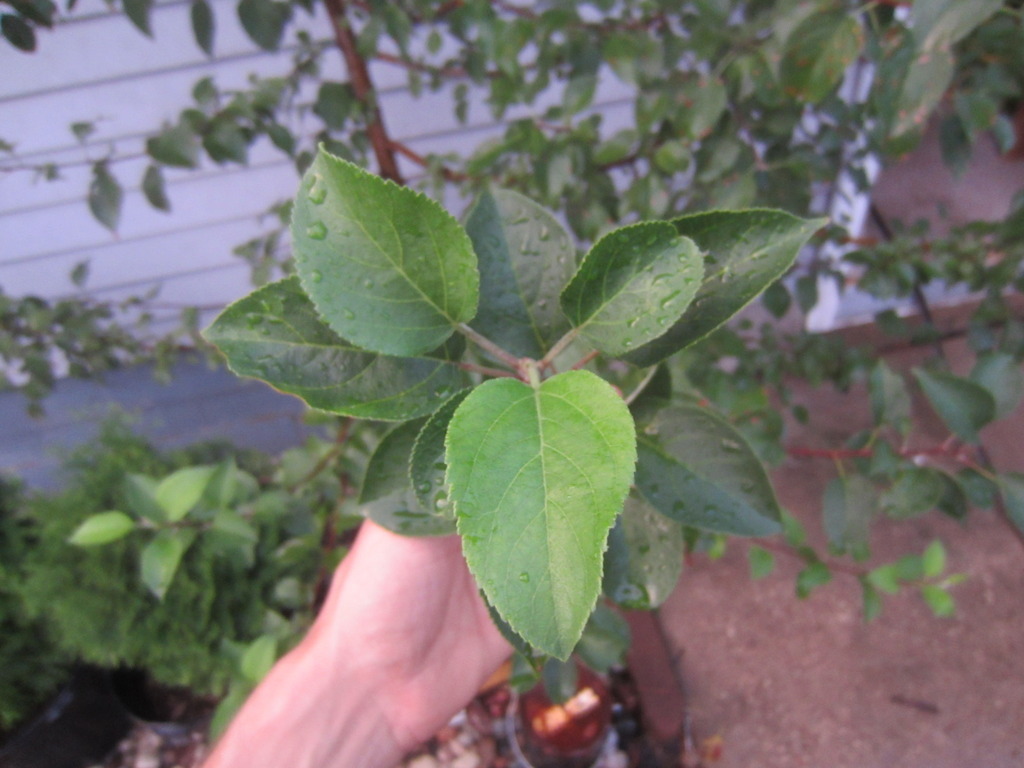I was just looking at the Honeycrisp graft i have on an inground seedling tree…no sprays (fungi/pesticide), no fruit on this tree…south facing…morning sun…hot for most of the day…some evening shading… it’s just ugly. I put a comparison branch right next to it… Nutrients? Sprays? Give up? I have several other grafts on this tree…might dig it up and give it away. I’ve also noticed my HC grafts don’t grow as much as other grafts.
It looks nearly that bad in west Texas. And no bloom long after others are bearing.
Did a little reading…this from MSU
"During July and August, Honeycrisp will develop leaf yellowing that in some years can be quite severe (Photo 1). This disorder is a genetic characteristic of Honeycrisp and is caused by excessive buildup of carbohydrates in the leaves. Yellowing is greatest on light crop load trees and limbs where there is no fruit to collect the carbohydrates from the leaves. The excessive carbohydrates cause the reduction of photosynthesis and leaf chlorophyll levels declines, turning the leaves yellow. This yellowing seems to have no detrimental effect on the trees, but looks severe. Some other varieties can get this yellowing (Photo 2), but this leaf yellowing also resembles leafhopper burn – Honeycrisp leaf yellowing is not caused by leafhoppers.
No fruit makes it worse…my situation.
Interesting! I wonder if that’s what’s discolored my peach and pluot leaves on occasion.
I’ve read that leaves only photosynthesize as much as needed. But didn’t know that they could lose chlorophyll as a result. Carbohydrate buildup is good for winter hardiness and cropping next yr. Maybe we’ll both get fruit soon.
I’m impressed they had a way to figure that out, I guess they could measure all kinds of things in some experiments.
My HC looks equally ugly. It is amazing that those leaves produce $5/lb apples in my area.
Maybe it is that concentration of carbos that makes HC foliage the most attractive to J. beetles. Between yellowing and beetle damage I can spot a HC tree from far away.
I know this is an old post but I’ve noticed an interesting thing on the two Honeycrisp grafted trees I have (6th leaf, no fruit yet). The two rootstocks are different and in different areas and the leaf condition of the two are very different. One is in full sun in my regular orchard, on a regrown Fedco Antonovka rootstock (orig tree died). It’s growing fine but the leaves are always very rough, even in “good” years for most apples. The second one is on a wild seedling, in a fair amount of shade in the edge of the woods. Its leaves look good, even in a “blighty” year like this year. Grafts were from the same scion stick. I hope they fruit soon to compare the fruit. Just an observation, no conclusions. Sue
I considered complete removal of my Honeycrispt but decided to keep a few grafted limbs and one small tree totally dedicated to HC. Based on all of the post above I probably made a bad decision keeping so much of it. Time will tell. When I go to almost any produce store HC is always present with a high price so surely some growers have figured out how to make them productive.
Mine did not started setting fruit until year 7 or 8 and has been biennial since. What a pain!!
So the healthier leaves are either the result of rootstock or shade- or a combination of the two. At least that is where my logic takes me. If you transplant the healthy tree into the full sun, we might actually learn something. The fruit probably won’t be great if there is too much shade anyway, although for me some shade seems to reduce the rot spots so prevalent on fruit from vigorous trees.
All Honeycrisp I manage are on 111, and you can identify them from a couple hundred feet away by their mottled leaves.
Text book honey crisp so no worries it looks great. First time I saw it on my what are now old honey crisp trees I flipped out and was googling apple mosaic for 3 weeks which is pretty funny looking back on things. They are a great apple but don’t expect them to behave like other apples because they are night and day different. For anyone who likes apple parentage articles related to this apple this is a great article https://www.ncbi.nlm.nih.gov/m/pubmed/28243452/. Once your honeycrisp tree starts producing more apples and they really do produce a ton of apples the yellowing of the leaves will lesson http://msue.anr.msu.edu/news/honeycrisp_leaf_yellowing_showing_up_on_michigan_apples
I’ve been reading up on this post and I’m having somewhat of a similar issue. the leaves don’t seem to be very yellow, but the color of the bark has a yellow tinge to it, is this the same issue with not producing fruit and the extra carbohydrates?? I’ll post some pictures of a nearby Macintosh tree and that looks a lot happier than my honey crisp tree any thoughts?









